Air compressor selection for higher altitude installations introduces some unique considerations that are often overlooked. A simple oversight will not only lead to disappointment, but a far less than satisfactory compressed air system – if it even operates! Higher altitude means less dense inlet and ambient air for both compression and cooling. Considerations must include a larger air compressor inlet capacity and footprint; high altitude rated motors, VFDs and even starters, all requiring greater cooling capacity; and larger cooling fans and air flows for air-cooled units or auxiliary components such as compressed air dryers.
Let’s look at a few significant factors when considering air compressor selection for higher altitude installations. First, there are the physics of pressure, temperature and relative humidity. Second, there is the physical size and capacity of the compressor unit being considered, whether positive displacement rotary screw type or dynamic centrifugal type. We will address and breakdown each of these factors.

The staff at CAC Group’s main office in Medellin, Colombia.
Formulas and Foundations
pV = nRT Ideal Gas Law
For atmospheric air, n and R can be assumed to be constant as air is as close to an ideal gas as there is.
This reduces to the Combined Gas Law (including Charles’s Law and Boyle’s Law) which then allows:
P1V1/T1=((P2V2))/((T2)) (or) V1=((V2T1P2))/((T2P1))
In practical terms comparing inlet conditions to standard conditions:
ICFM=SCFM x ((T1))/((Ts)) x Ps/((P1-∆p)-(Pv)(RH))
ICFM = Inlet cubic feet/minute (Volumetric Flow)
SCFM = Standard cubic feet/minute (defined at 14.7 psia, 60°F, 0% RH, which = Mass Flow)
T1 = Ambient temperature at site °R (°F + 460)
Ts = Standard Temperature °R (60°F + 460, in our case)
P1 = P ambient at site psia
Ps = 14.7 psia at sea level (in our case)
∆P = Nominal air inlet filter/piping pressure drop psia
Pv = Partial vapor pressure of water psia at T1
RH = Ambient site relative humidity %
High Altitude Factors to Consider
The primary ambient factors for air compressor capacity definition and selection include atmospheric pressure (P1) or altitude, inlet air temperature (T1) and the relative humidity (RH) for any given set of operating conditions. Let’s look at each factor.
Pressure: Atmospheric pressure decreases with altitude as the air density decreases. There are less molecules or moles in the same given volume of air. Molecules and moles or mass are the energy workhorse for compressed air. This means the inlet pressure to the air compressor at some elevation is measurably less than at sea level. To achieve the same desired discharge pressure the air compressor has to work harder to overcome the increased pressure ratio. The air density decrease is linear as the elevation goes up. This is the Ps/(P1- ∆P) factor above and can be up to a 40% capacity correction factor above sea level. Site atmospheric pressure is the most significant factor to understand. It is assumed constant at the installation site but must be identified correctly.
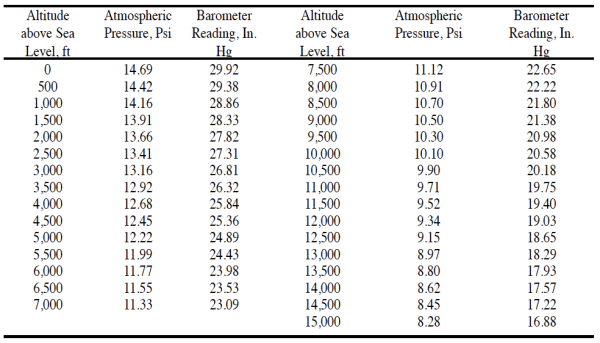
Atmospheric pressure and barometer readings at different altitudes (table courtesy of CAGI, from CAGI Handbook, 6th Ed.)
Temperature: As ambient air temperature increases, the molecules expand and the density goes down. As with altitude there are also fewer molecules or moles in the same given volume of air. The air density decrease is linear as temperature increases and gives us an absolute temperature ratio factor in degrees R. This the T1/Ts factor above and can be up to a 7% capacity correction factor above standard conditions.
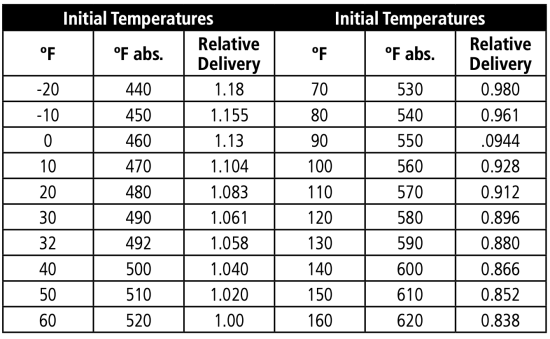
Effect of initial or intake temperature on delivery of air compressors based on a normal intake temperature of 60°F (table courtesy of CAGI, from CAGI Handbook, 7th Ed.)
Relative Humidity: As ambient air temperature increases, the partial vapor pressure of the air also increases. That is, warmer air is able to hold more moisture in the first place. This vapor content increase is exponential. This is the (Pv)(RH) factor above and can be a 6% or more capacity correction factor above standard conditions.
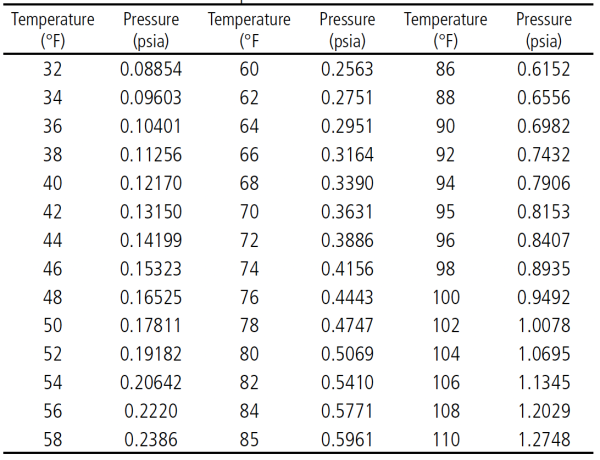
Pressure of water vapor at separation (table courtesy of CAGI, from CAGI Handbook, 7th Ed.)
The relative humidity is the percent of water vapor in the air at a given ambient temperature. Water is generally incompressible and serves no useful energy contribution to a compressed air system. Get rid of it. Generally, compressor interstage cooling, aftercooling and later downstream air drying will collect most of the condensed water vapor that entered the compressor inlet before it enters the compressed air system.
After compression, single or multistage, and final aftercooling the compressed air is still 100% saturated now at system design pressure. The remaining water vapor or moisture content is about 30% of the initial ambient moisture volume. Water will continue to condense with any further temperature drop and needs to be removed or drained to maintain a dry air system. This water volume is also a capacity loss from the initial volume of humid air going into the air compressor inlet and must be accounted for.
Compressed air drying will further reduce the water vapor content helping to avoid condensation in air piping and instruments, as well as related system problems. Compressed air dryers are designed to reduce the final discharge pressure dew point such that there will be no further condensation if the compressed air temperature stays above the system designed compressed air dew point. These pressure dew point values are typically 35 to 50°F (2 to 10°C) for refrigerated dryer systems (at 35°F around 4% water vapor content remains) and -40°F (-40°C) for desiccant dryer systems (roughly 0.1% water vapor content remains).
We all know the main sizing selection considerations when comparing a nominal manufacturer’s capacity rating and your actual jobsite conditions.
An air compressor is sized based on physical inlet volume. A compressed air system is designed based on the amount of useable energy which is delivered in compressed mass flow. The relative comparison is most often evident by looking at the volume or inlet cubic feet per minute (icfm) vs. the delivered mass flow expressed as standard cubic feet per minute (scfm). There are at least a half dozen common and acceptable standard definitions for scfm used in different industries and different parts of the world. Be sure you are consistent in your evaluation. For this discussion we will define scfm at the conditions of 14.7 psia, 60°F and dry.
Let’s look at an example that displays all factors:
A customer in Denver, Colorado, needs a 1,000 scfm air compressor designed for a summer day, 95°F, 80% RH, 5,280-foot elevation which equals 12.1 psia. We need to calculate the icfm required to deliver 1000 scfm.
Using the above equation, we have:
ICFM=1,000 x ((95+460))/((60+460)) x 14.7/((12.1-0.2)-(0.8153)(0.80))
ICFM=1,000 x 1.067 x 1.307
ICFM=1,395
In total, our compressor selection needs to be about 40% larger than at sea level to do the same work.
Another way to see the effect of water vapor and relative humidity is to look at the volume of condensate to be removed. For our case of 100 psig, 95°F, 1,000 scfm, we see there are roughly 2.25 lbs. condensate per 1,000 cubic feet of air, or 0.27 GPM (about a quart), or 16.2 GPH (about a keg), at the air compressor inlet.
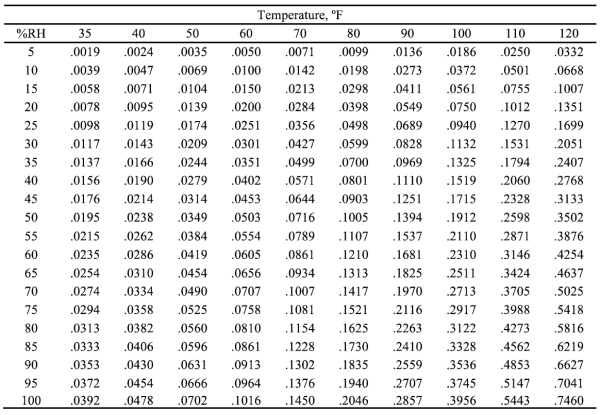
Moisture content of air in gallons per 1000 cubic feet (table courtesy of CAGI, from CAGI Handbook, 7th Ed.)
Ambient air weight at 14.7 PSIA, 95°F is about 70 lbs. per 1000 cubic feet. Ambient air weight at 5,280 feet altitude is about 58 lbs.
At 80% relative humidity (RH), this same 58 lbs. of air also includes 2.25 lbs. of water vapor. Therefore, nearly 4% of the total weight of the inlet air is water weight which is useless to the compressed air system and needs to be removed in the quantities above.
Conclusion: do not budget shop for a nominal 1,000 cfm compressor, with maybe a 250-horsepower (hp) motor. We need to look at a nominal 1,500 icfm size air compressor with 350 to 400-hp to get the desired 1,000 scfm mass flow delivered to the compressed air system.
While the effect of altitude is notable in the U.S., particularly in Denver, Salt Lake City and snowmaking system locations, it is critical in Latin America. There are many more higher altitude metropolitan areas, industrial operations and populations in the Latin America region including Mexico City, Mexico (7,300-feet, 22 million), Bogota (8,600-feet, 11 million) and Medellin, Colombia (5,000-feet, 4 million), Quito, Ecuador (9,300-feet, 2.1 million) and La Paz, Bolivia (11,900-feet, 3 million). These five areas alone have more population and related industry than 12% of the entire United States population.
For comparison reference, using the above calculation on a standard 60°F, dry day at 10,000-foot elevation, a 1,000 scfm demand will require a 1,480 icfm sized air compressor. All air compressor sizing selections for the above noted areas are typically in the range of 150% icfm vs. icfm for equivalent mass flow (usable compressed air energy).
Daniel Mejia examines the installation of an 800-hp FS-Elliott centrifugal compressor in a textile company in Mexico.
Air Compressor Selection for High Altitude
When choosing between rotary screw air compressors and centrifugal air compressors for higher altitude installations, it is essential to account for the specific conditions of the customer's site. While centrifugal compressors are often selected based on customer-specific conditions, screw compressors are typically designed for operation at sea level. Therefore, when installing a screw compressor at high altitude, it is necessary to reselect the compressor to ensure optimal and correct performance under the atmospheric conditions.
Rotary screw air compressors, operate based on positive displacement, trapping air between two meshing helical screws, and reducing the volume to increase pressure. These compressors are recognized for their efficiency, reliability and relatively low maintenance requirements. They are commonly used in various applications, but when operating at high altitudes, adjustments must be made to accommodate the reduced atmospheric pressure. Note in our example the nominal icfm increased by 40%.
Centrifugal air compressors operate by accelerating air radially outward from the impeller and converting kinetic energy into pressure energy. When selecting centrifugal air compressors, factors such as altitude and specific site conditions are always considered to ensure optimal and correct performance.
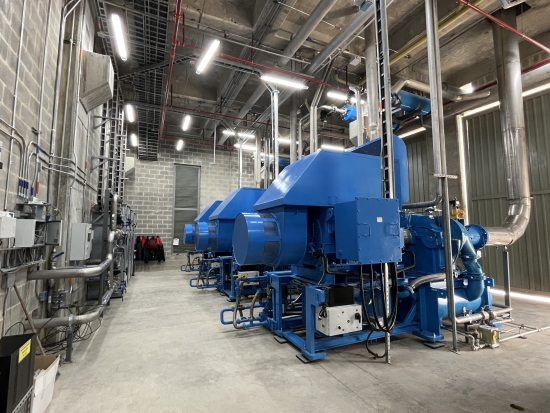
At this glass manufacturer, three centrifugal compressors boasting a power output of 745 kW each supply operations at an elevation exceeding 8,200 feet. With an airflow capacity of 4,740 scfm or 7,000 icfm each, these compressors are crucial for sustaining production efficiency. Notably, the specific power rating of 10.64 kW/100 icfm ensures optimal performance in high-altitude environments.
When selecting between rotary screw air compressors and centrifugal air compressors for high altitude installations, several factors should be considered:
- Altitude adjustment: For rotary screw air compressors, adjustments must be made to accommodate reduced atmospheric pressure at higher altitudes to ensure correct optimal performance.
- Customer-specific conditions: Centrifugal air compressors are typically selected based on specific customer conditions, including altitude, air demand and other site-specific factors.
- Energy efficiency: Evaluate the energy efficiency of each compressor type under the customer's specific operating conditions to minimize energy consumption and operating costs.
- Maintenance requirements: Consider the maintenance needs and associated costs of each compressor type to ensure reliable operation over the lifecycle of the compressors.
- The footprint, size and weight of a positive displacement rotary compressor increases greatly as the icfm rating goes up. The dynamic centrifugal also increases but at a more nominal rate. Model, frame and motor size increase directly relates to cost increase. Try to maximize the frame size capacity limit to get the flow you need.
- Operational factors at higher altitude include more cooling capacity for the motor requiring a high-altitude motor rating, more VFD cooling and certainly more cooling air flow for an air-cooled compressor. These larger package options and ratings must be included to get a reliable running unit.
In conclusion, both screw air compressors and centrifugal air compressors offer unique advantages and are suitable for different applications. When selecting an air compressor for high altitude installations, it is essential to consider all the specific operating conditions and requirements of the customer's site to ensure optimal and correct capacity, performance and efficiency for your location.
CAC Group: A Premier Distributor for Air Compressors in Latin America
Jim Hudson, Vice President, Daniel Mejia, Manager, and Bruno Rebessi, Owner and President, CAC Group.
In the dynamic landscape of industrial solutions, CAC Group (CAC) stands out as a key player, specializing in air compressor sales and service throughout Latin America – from Mexico to Patagonia, the Andes mountains to the tropics. CAC was created as an independent, fully-authorized service compressed air house and rotating machinery distributor based in Miami by Bruno Rebessi, formerly Regional Manager for Elliott Turbomachinery. CAC celebrated its 20th anniversary this May and is now a sales and service organization of over 50 people including 40 engineers. CAC understands the unique challenges of the Latin American market. It provides local comprehensive engineering and authorized service support for tailored solutions to meet the diverse needs of its clients and the whole range of difficult environmental and operating conditions. Its engineered solutions deliver efficiency, reliability and productivity with the least downtime in the most demanding industrial applications. In this a large geographical area, all markets and industries are represented. In Latin America, the petroleum industry is nationalized and controlled by local governments. CAC has installations in most oil refineries and petrochemical companies in the region. It has compressor installations in the extensive mining and smelter operations throughout the Andes mountains for copper, gold and silver for the traditional markets and now lithium, which is especially important today for the future of EV technologies. Glass, food and beverage, automotive, electronics, textile and air separation industry air compressor installations are also well represented with both local and international companies.
|
Images courtesy of CAC Group.
About the Authors
Daniel Mejia is General Manager for Compressed Air Corp, with 22 years of experience in Latin American compressed air and general rotating equipment industries.
Jim Hudson is Vice President, Business Development for Compressed Air Corp, with 45 years of experience in the compressed air industry in worldwide sales and product marketing for a variety of compressed air components and systems. He’s also a former CAGI Centrifugal Committee Chair and Board Member.
To read similar articles on Air Compressor Technology, please visit https://www.airbestpractices.com/technology.
Visit our Webinar Archives to listen to expert presentations on Air Compressor Technology at https://www.airbestpractices.com/webinars.





